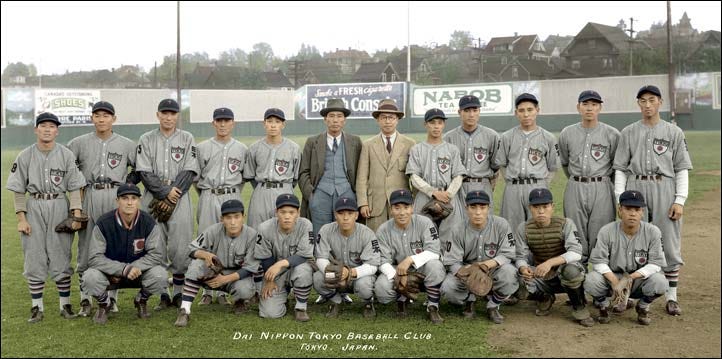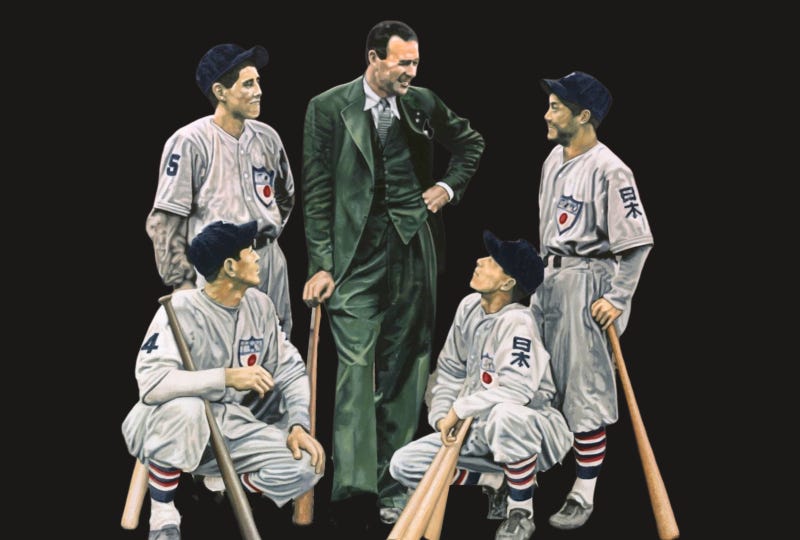Spalding Guide #4 - The Man Who Introduced Baseball to Japan (Baseball Trivia)
Get your dose of baseball trivia...right now!
Welcome to week 1 of the offseason, and week 2 of the Spalding Guide. Except, I’m actually writing this edition last Friday. So greetings from the past?
Speaking of the past, I seem to be diving deeper and deeper into baseball’s past for our questions (just wait until you see how far back we had to go on Friday). I’m not going to break that habit just yet as today’s question has to do with the early days of Japanese baseball.
Last week I mentioned Lefty O’Doul, and the San Francisco Seals. Lefty, who is credited for discovering Joe & Dom DiMaggio, had a long relationship with the New York/San Francisco Giants is also credited for being a father of modern Japanese baseball. He went to Japan at least a dozen times over his career, first as part of an exhibition tour in 1931, and the next season he went back for three months hosting training sessions for Japanese players. Over the next three decades, he would organize trips for barnstorming teams featuring the likes of Babe Ruth, Jimmie Foxx, Connie Mack, Bobby Shantz, Yogi Berra & Joe DiMaggio (and plenty of players from teams other than the Yankees & Philadelphia A’s….). In 1952 he and the New York Giants toured “The Orient”. Two years later, O’Doul would join a Japanese all-star team, managing them through a tour of Australia.
He tried to broker a trans-Pacific World Series featuring the champions of Japan versus the World Series winners, and scouted Japan and the Philippines for the Hawaii Islanders of the PCL.
In 1935, the Dai-Nippon Tokyo Yaku Kurabu, a Japanese all-star team, would barnstorm the United States playing minor league & college teams. The team went an impressive 75-33-1, playing 109 games in 128 days. In the middle of the tour, Lefty O’Doul suggested that, for marketing purposes in the States, the team use the name “Tokyo Giants”. When Dai-Nippon returned to Japan, the team went pro and joined the new Japanese Baseball League in 1936 as the Tokyo Kyojin. In 1944 the team would officially change their name to the Tokyo Giants, and later the Yomiuri Giants. The team, which has often been described - ironically - as the “New York Yankees of Japan” have won 31 professional baseball championships across two professional leagues, and has represented the country in several international club competitions. Japan’s Giants and the San Francisco Giants share more than a name, the Yomiuri Giants logo and jerseys are based on their NY/SF namesakes.
For his contributions, Lefty O’Doul was elected to the Japanese Baseball Hall of Fame in 2002. He was the first American to be honored this way. Which brings us to the subject of today’s question.

While Lefty O’Doul was instrumental in modernizing and improving Japanese baseball in the 30s, 40’s and 50’s, an American educator is responsible for introducing the game to the island country less than 30 years after the Knickerbockers and the New York Nine met at Elysian Fields for the first time.
Now the question: This Civil War veteran and 2003 Japanese Baseball Hall of Fame inductee is credited with introducing the game of baseball to Japan. Can you name him?
If you know, answer in the comments!
Friday’s answer: This Bob Ferguson-lead team only played two seasons in the National League of Professional Baseball Clubs, and only boasts of one Hall of Famer. But this team’s players are credited with creating the curveball, off-bag positioning for first basemen, and the bunt. Can you name the team?
For a bonus, name the players.
Correct answer: Hartford Dark Blues.
In 1874 Morgan Bulkeley, president of the United States Bank of Hartford and two partners leased land at the corner of Hendrixon & Wyllys in Hartford from Colt Manufacturing Company heiress Elizabeth Colt to build a baseball ground and a baseball club. The team, captained by Bob Ferguson, was initially called the Hartfords and competed in the final two seasons of the National Association (which we all know was the first professional baseball league). The team, now known as the Dark Blues because of the color of their uniforms, joined the upstart National League for the 1876 season. The team moved to Brooklyn for the 1877 season and played as the Brooklyn Hartfords. The Hartfords folded after the completion of the ‘77 season, leaving Brooklyn for the first time, but not the last, without a team.
Before going gently into that goodnight, the Dark Blues made some very significant contributions to the game of baseball.
For the bonus: Candy Cummings, the Dark Blues’ only Hall of Fame representative, is credited for having developed the curve ball. Which was something of a scandal in an era when batters could request the hurler pitch to a specific location.
Thomas Barlow created the bunt. Barlow is the subject of a rather sad aside in baseball, he was injured while playing for the Dark Blues, and his physician administered a shot of morphine. That proved to be an unfortunate turning point in Barlow’s career and life. You can hear a letter he wrote, lamenting his drug addiction, read by David Caruso in Ken Burns’ Baseball. In 1873 Barlow caught all 53 of the Brooklyn Atlantics’ games. He was the second player to catch all of his team’s games. The third didn’t occur until 1945 when Mike Tresh caught 150 for the White Sox. Barlow was a lifetime .290 hitter who spent his entire career in the National Association.
“Old Reliable” Joseph Start had a career that gleams in opposition to Barlow’s. Playing in 27 campaigns in both the NA (joining in the inaugural 1871 campaign) and the NL. Besides playing for the Brooklyn Atlantics, and being on the team that ended the Cincinnati Red Leggings’ titanic 81 game winning streak, Start also changed the way first base is played. During his career, that spanned an era of massive changes to the game, Start was the first first baseman to play off the bag. Joseph Start is thought to be the last pre-Civil War baseball player to retire from the game. He did so in July 1886 while with the Washington Nationals (no, the other Washington Nationals).
Hope you enjoyed today’s edition of the Spalding Guide. Check back tomorrow for the answer to today’s question and a brand new question. Until then, don’t forget to subscribe (and if you’re amenable, share) this humble little Substack.



